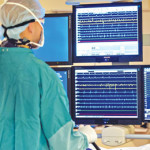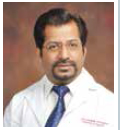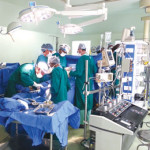
 Cardiac monitoring and diagnostic devices manufacturers are facing survival challenges in todays marketplace while the need for innovative and safe products continues to grow, writes Anshuman Ojha of Elets News Network (ENN)
Cardiac monitoring and diagnostic devices manufacturers are facing survival challenges in todays marketplace while the need for innovative and safe products continues to grow, writes Anshuman Ojha of Elets News Network (ENN)
Cardiovascular Diseases (CVDs) are the largest cause of deaths globally, around 17.3 million people died from cardiovascular diseases in 2008. This amounts to 30 percent of all deaths. Of these, an estimated 7.3 million were due to coronary heart disease and 6.2 million were due to stroke. Low- and middle-income countries are the largest affected with CVDs. An estimated 80 percent of CVD deaths take place in low- and middle income countries. By 2030, almost 23.6 million people will die from CVDs, mainly from heart disease and stroke and are projected to be the single leading causes of death.

With the number of people suffering from cardiovascular diseases and the condition upswings globally, the demand for cardiovascular devices is growing. Around 30 million people are severely affected by cardiovascular diseases every year. A considerable market growth is expected in the stress testing systems and diagnostics all over the world by the emerging markets.
Currently, up to 11 percent of Indias urban population and 3 percent of its rural population over the age of 15 have diabetes
Market Dynamics

The global cardiac monitoring and diagnostic devices market was valued at US$ 4.06 billion in 2012 and is expected to reach a value of US$ 7 billion in 2019, growing at a CAGR of 9.7 percent from 2013 to 2019. This market comprises of Electrocardiograph (ECG) monitoring systems, ECG stress testing systems, Holter monitoring systems, ECG data monitoring systems, event monitoring systems, cardiovascular monitoring and diagnostic devices and cardiopulmonary stress testing systems. Globally, Event monitors and ECG systems together account for approximately 33 percent of the market and are expected to support the cardiovascular devices industry going forward.
On a global scale, projections for cardiac telemetry systems market value indicate nearly 40 percent by 2015 leaving the rest of the market to the event monitors and ECG systems. By end-user, home/emergency is one of the fastest growing segments accounting for US$ 741 million market value by 2016.
Higher penetration of health care insurance products and the increased focus of multinational cardiovascular companies have been the major drivers of the cardiovascular devices market in emerging countries
However, the global market for implantable loop recorders (ILR) will be growing at a faster rate owing to a new technology attracting many customers in the developed region who can afford such devices. Besides, Holter systems is expected to follow the ILR segment in terms of growth rate, due to rising demand for continuous monitoring which gives the physician a better picture of the patients condition.
The resting ECG dominated the ECG systems market in 2012 owing to high demand for these systems by patients. Cardiologists demand resting ECG systems for its low price than stress ECG systems. Moreover, resting ECG systems is preferable for elder patients and those with high risk of stroke.
North America dominated the cardiovascular monitoring and diagnostic devices market in 2012 and is expected to maintain its lead position in the global market till 2019. However, the Asia-Pacific market is estimated to grow at a higher Compounded Annual Growth Rate (CAGR) of 11.9 percent from 2013 to 2019 due to increasing awareness about cardiovascular disorders and monitoring and diagnostic devices. Asia-Pacific region shows a rapid increase in the incidence rate for coronary artery disease, deep vein thrombosis and peripheral artery disease, which will expedite the demand for cardiovascular monitoring and diagnostic devices.
Increased prence of cardiovascular and lifestyle diseases are driving the cardiovascular devices market in emerging countries.
Lifestyle changes have led to a growing incidence of lifestyle diseases in emerging countries. It has been recently projected that the incidence of cardiovascular disease will increase by 73 percent by 2030 in China.
The prence of risk factors such as diabetes and obesity is increasing in China, India and Brazil. Dietary changes, undue stress and changes in lifestyle are leading to more cases of diabetes, obesity, hyper lipidemia, smoking and hypertension, which are all major risk factors for developing cardiovascular diseases. India has the highest number of disability adjusted life years (DALYS) lost due to CHD of the emerging economies in the world. The number of DALYS lost in India stands at 20 days per 1,000 people, closely followed by Brazil. DALYS combines the years of potential life lost due to premature death with the years of productive life lost due to disability.
The International Diabetes Federation (IDF) estimates that the number of patients with diabetes in India has more than doubled from 19 million in 1995 to 50.7 million in 2010. It is projected to increase to 69.9 million by 2025. Currently, up to 11 percent of Indias urban population and 3 percent of its rural population over the age of 15 have diabetes.
Developing countries are also witnessing the fastest growth of obesity. In these countries, the prence of obesity has more than tripled. Cardiovascular disease prence and the rising incidence of lifestyle disorders are the main factors for the increase in the population pool suffering with cardiovascular diseases, which is a major driver for the cardiovascular devices market in the emerging countries.
China had the largest cardiovascular devices market in 2010 among the emerging countries, with a total market value of about US$ 1 billion. This value is estimated to reach US$ 1.3 billion in 2017. The cardiovascular devices market in India was the second largest cardiovascular devices market among the emerging countries and was valued at US$ 476 million in 2010. It is expected to reach US$ 589 million in 2017. The cardiovascular devices market in Brazil in 2010 was worth US$ 490 million and is estimated to reach US$ 759.2 million in 2017. The rise in cardiovascular disease incidence, the increased spending power of the population, the higher penetration of health care insurance products and the increased focus of multinational cardiovascular companies have been the major drivers of the cardiovascular devices market in emerging countries.
The market will grow at a healthy pace in the next five years due to the increasing incidence of cardiovascular diseases, technological advancement, rising cost of cardiac disease treatment, and government regulations in favour of cardiac monitoring.
 India is growing as an Important Destination for Cardiac Medical Tourism
India is growing as an Important Destination for Cardiac Medical Tourism
India is gaining importance as a destination for medical tourism and in particular for the treatment of cardiovascular diseases and surgeries. Complex cardiovascular procedures such as cardiac bypass surgery, cardiac valve repair and replacement and minimally invasive cardiac stenting and angioplasty are procedures that are quite easily taken up in various urban hospitals in India at a lower cost than in the West and even other Asian countries.
The low cost of treatment, scale and range of treatment options provided in India, the availability of world class infrastructure, proficient English speaking doctors and paramedical staff and the adoption of medical technologies are some of the factors that are facilitating Indias growth as a center for medical tourism.
GE Healthcare, Philips Healthcare, Siemens Healthcare, Nihon Kohden, Cardiac Science Corp (now OptoCircuits) and Schiller AG are the leading companies in the global Cardiovascular Monitoring and Diagnostic devices market, with a combined share of more than 60 percent. Other aggressive players include St. Jude Medical, Inc, Boston Scientific Corporation, CareFusion Corporation, Spacelabs Healthcare, Inc and Welch Allyn, Inc.
The global cardiac diagnostic industry is a diverse and highly competitive market. It is anticipated that demand for cardiac diagnostic products and services will continue to rise providing opportunities for both the existing market participants and the emerging market participants. Manufacturers should look for ways to distinguish themselves in the marketplace by keeping abreast of key market drivers, restraints, and trends that are affecting the market and the economy as a whole. More than ever before, manufacturers are facing survival challenges in today’s marketplace while the need for innovative and safe products continues to grow.
Technology Advancements
The days of keeping a patient in the hospital for cardiac monitoring are gone. Many patients cannot afford to spend the night in a hospital because the costs are too high. Additionally, most patients have no need to spend the night in a hospital since they are only having their heart monitored. With modern technology, it is possible for doctors to monitor cardiac activity while allowing patients to live their lives in a normal way.
There are a variety of advancements made to the cardiac monitor that are highly beneficial to doctors and patients.
Real-Time Activity
The problem with old-fashioned cardiac monitoring was that the results had to be downloaded from a mobile machine. A patient would have to wear a monitor for 24 hours and then go into the doctors office for the results to be seen. Now, doctors can either schedule the results to be sent or patients can hit a button to send the results. All of the numbers can be seen in real-time, ensuring that cardiac monitoring is done properly.
Wireless
There is no need for patients to be strapped to the bed for cardiac monitoring anymore. While patients will still have wires on them and to the machine, nothing has to be plugged in. Many are able to wear a monitor and go to the grocery store and even work so they can proceed through the day as normal. New technology has provided batteries that last longer and are lighter so that patients can have a more productive day “ and have their heart monitored outside the hospital walls.
Mobility is a huge benefit as a result of modern technology. Computer chips have gotten smaller and new materials have been used in order to provide a mobile cardiac monitor. The primary benefit is that doctors can learn about a patients cardiac activity while they do day to day tasks. The secondary benefit is that the data can be sent over a wireless connection so that doctors have more mobility as well. There are many doctors who work in their own practice as well as in a hospital. If they have a patient in the hospital for cardiac monitoring, it would be impossible to spend time at their practice.
Now with mobile monitors, doctors can essentially be in two places at once. With the other benefits to the mobile monitors, doctors can get alerted if there is a problem with a patient so they know what location they need to be in.
 |
Dr Deepak Khurana Director Cardiothoracic and Vascular Surgery, Rockland Hospitals, New Delhi |
| MICS “ A Whole New Branch of Cardiac Surgery | |
|
Earlier the coronary artery bypass grafting (CABG) surgery was done using cardiopulmonary bypass machine, making the heart still. But nowadays, the trend is to perform the same surgery in a beating heart without using cardiopulmonary bypass machine, using cardiac surface stabiliser. All this leads to lesser complications, faster recovery of the patients after the surgery, its economical and lesser hospital stays. Apart from this, earlier a long incision used to be given in chest midline to perform any major Heart Surgery but now small incision or side hole operative technique is used to avoid a long scar and issues of post operative wound healing. This whole new branch of cardiac surgery is called Minimally Invasive Cardiac Surgery (MICS). Further, the technological advancement in the quality of valves available to us now for valve replacement (mostly mitral/aortic) surgery is more durable, long lasting and better performance leading to lesser complications. This makes the surgery more patient friendly and many patients lead a normal life. In the future, technology is being developed to make the diagnosis, assessment and treatment of the heart problems less invasive and more patient friendly but this requires a learning curve and use of technology, which is usually expensive and has high complication rate initially. In more experienced hands it can still be safely used. The third world countries offer a challenge to make the use of technology affordable for the use of masses. |
|
Alerts
Alerts can actually be sent to the doctor when cardiac monitoring shows something that could be troubling. This will ensure that a doctor can call the patient and find out what they are doing or order them to come into the hospital if there are unusual rhythms or a high/low pulse situation. Doctors are able to monitor more patients when they can receive alerts, making it possible for more patients to get a higher level of healthcare.
One-Piece Devices
Traditional Mobile cardiac outpatient telemetry (MCOT or MCT) systems have been two-piece systems that contain a receiver and a transmitter. The two-piece equipment contains wires that are attached to leads, which close the circuit from the heart to the receiver to the transmitter. Recent developments in MCT technology have created a one-piece device that can store data for up to thirty days. The one-piece device features a single receiver/recorder. One-piece designs are appealing to patients because they only have to worry about one piece of equipment, and it is less obtrusive.
Extended Holter
Extended Holter, or patch technology as its commonly known, is a long term Holter device and not MCT technology. Though the patch does not require wires, it is a two piece technology that requires data to sync to a remote device via Bluetooth technology. Though this Band-Aid Style Patch adheres directly to the patients chest without wires, it is fairly large at roughly 5 inches long, 2 inches wide and more than an inch thick.
GPS and Accelerometers
MCT devices are now integrating GPS technology and accelerometer metrics. These additional measurements enhance the data that the MCT transmits to the cardiologist, which then enhances diagnostic abilities. The GPS feature allows the physician to gather geographic data about where the patient was during different points in the data. The accelerometer provides a picture of the activity that the patient was engaging in at the time of an event. These features provide a broader scope and more detailed evidence that can help cardiologists understand the status of their patients heart function.
Indian healthcare industry has been witnessing a drastic change regarding the new innovation and technology, which in terms are applied in improving from sector to sector since the past 3-5 years. Cardiovascular industry growth continues to increase with the presence of multiple technologies such as advanced material and software which is featured in most of the devices. International companies tend to innovate, develop new products and to enhance the existing features in cardiovascular devices.
Be a part of Elets Collaborative Initiatives. Join Us for Upcoming Events and explore business opportunities. Like us on Facebook , connect with us on LinkedIn and follow us on Twitter , Instagram.













